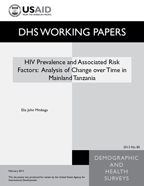
Abstract:
Introduction:
HIV is one of the worst epidemics ever, with
about 22.5 million people in sub-Saharan
Africa living with the virus. The epidemic is
extremely heterogenic and dynamic. HIV
prevention depends upon a good understanding
of population-specific transmission
determinants. Therefore, this study of the
magnitude and determinants of the recently
observed decrease in HIV infection in
Tanzania will help define the future
direction of HIV interventions in the
country.
Methods:
Data from the 2003/04 and 2007/08 AIDS
indicator surveys from Mainland Tanzania were
used in this analysis. In these surveys a
multi-stage cluster sampling method utilizing
two-stage sample design was employed to
recruit participants age 15-49 from
throughout the country. Socio-demographic,
behavioral and biological determinants for
HIV transmission were collected, and HIV
testing was done to all consenting
participants. In this analysis, data were
restricted to Mainland Tanzania, people who
reported to be sexually active, and people
who had a valid HIV test result. A total
sample of 3,944 men and 5,213 women from the
2003/04 survey and 3,708 men and 5,311 women
from the 2007/08 survey were included in this
analysis.
Results:
Apart from a significant increase between
2003/04 and 2007/08 in the proportion of
people reporting having ever had an HIV test,
other socio-demographic, behavioral and
biological variables remained similar across
the two surveys. Overall, HIV infection
decreased by 14% (from 7.9% to 6.8%) over the
four years between surveys, but this decrease
was only significant among urban males. In
both surveys among both women and men,
formerly married individuals were at higher
HIV risk, In the 2007/08 survey, however,
single women were 60% less likely than
married women to be infected. Risk of
infection increased with wealth for both
sexes and in both surveys. Risk was two to
three times higher among rural residents
compared with urban residents. In the 2007/08
survey educational attainment was associated
with HIV infection in rural areas but not in
urban areas. Having many lifetime sexual
partners was a risk factor among both men and
women, in both rural and urban areas, and in
both surveys. Having a sexually transmitted
infection (STI) was an important biological
determinant for HIV infection in the 2007/08
survey, with twice the likelihood of
infection for infected men and women compared
with those uninfected. Male circumcision was
associated with 60-80% lower odds of HIV
infection.
Conclusion and recommendation:
HIV prevalence is decreasing among men in
urban areas of Tanzania. Overall, men and
women have similar determinants of HIV
transmission, as do rural and urban
populations. However, the study identified a
number of transmission determinants that
varied by sex and by urban-rural residence
across the two surveys. Hence, interventions
must address specific determinants in order
to be effective. Similarly, interventions
must address urban and rural populations
separately.
 HIV Prevalence and Associated Risk Factors: Analysis of Change over Time in Mainland Tanzania (PDF, 546K)
HIV Prevalence and Associated Risk Factors: Analysis of Change over Time in Mainland Tanzania (PDF, 546K)
